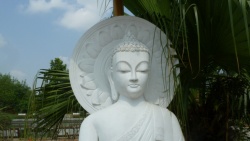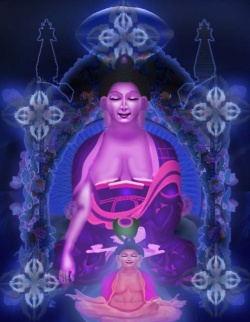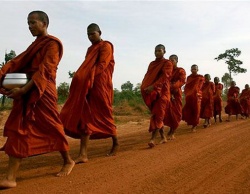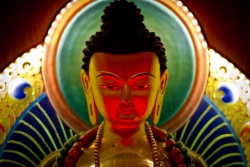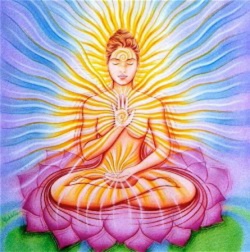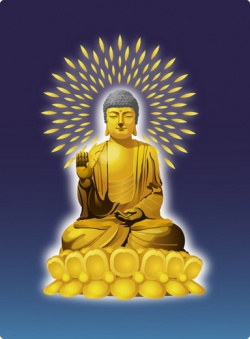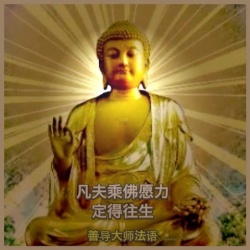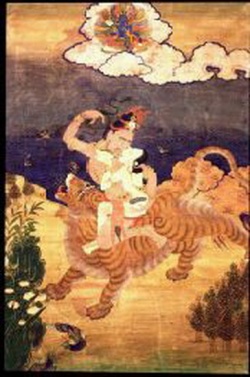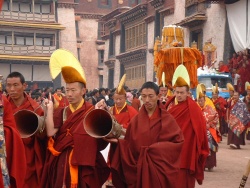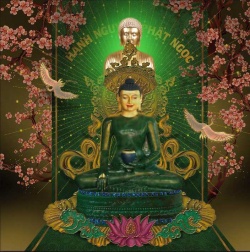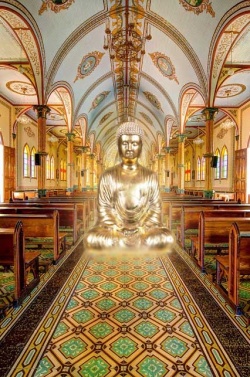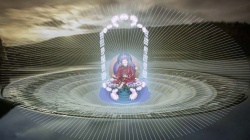Tibetan Yoga and Secret Doctrines
Preliminaries
The excellent translations and interpretations set forth in this volume by Dr. Evans-Wentz constitute one of the most original and, in some respects, the most unique contribution made to the Western World." - Professor Chen-Chi Chang [Tiy xlii].
Mahayana can be described as a loosely bound bundle of many teachings, and it is the largest form of Buddhism today. It was founded in India. This page contains formerly secret doctrine of Mahayana Buddhism as preserved and perhaps a little developed in Tibet and Himalayan countries.
The following contains excerpts from a book edited by W. Y. Evans-Wentz, Tibetan Yoga and Secret Doctrine. You can find book data at the bottom of the page.
"The Foundation of all is uncreated, uncompounded, independent, beyond mental concept and verbal definition. Neither the term sangsara nor the term nirvana can be applied to it. To realize It is to attain Buddhahood. Not to realize It is to wander in the sangsara.
"Not knowing the Foundation, beings aforetime erred. They were overwhelmed by the darkness of unconsciousness, whence sprang ignorance and error. Immersed in error and obscured by ignorance, the "knower" became bewildered and afraid. Then arose the concepts "I" and "Others', together with hatred. When these had grown strong, there was born an unbroken current of sangsaric evolution. Then the "five poisons" of the obscuring passions, lust, anger, selfishness, delusion, and jealousy, flourished, and there was produced . . . karma.
"The root-source of error among sentient beings is thus unconscious ignorance . . . May each of them realize the radiant, immaculate . . . innate in every living thing."
From The Good-Wishes of the All-Good Buddha Samanta-Bhadra [Tiy vi].
On the Editor, Dr. Evans-Wentz
The anthropologist Walter Yeeling Evans-Wentz was born on February 2, 1878 in Trenton, New Jersey. He attended Stanford University where he received his B.A. and his M.A. Afterwards he travelled extensively in Mexico, Europe, and the Far East. In one travel account he writes:
I have spent more than five years . . . wandering from the palm-wreathed shores of Ceylon, and thence through the wonderland of the Hindus, to the glacier-clad heights of the Himalayan Ranges, seeking out the Wise Men of the East. Sometimes I lived among city dwellers, sometimes in jungle and mountain solitudes among yogis, sometimes in monasteries with monks, sometimes I went on pilgrimages. [◦Answers.com Link]
In 1907 Dr. Evans-Wentz began to journey through Brittany, Cornwall, Scotland and Ireland to interview people who had encountered fairies. Evans-Wentz recounts reports in a book he wrote, The Fairy-Faith in Celtic Countries. Later he lived in India and in Sikkim and spent several years studying hidden doctrines intensively. He became a Buddhist monk too.
He was a pioneer in the field of Tibetan Buddhism and edited several books on it. Four volumes specked with insider comments, were published on Oxford University Press. Below are salient points from one of them.
The scholar meant to settle permanently in India, but returned to the United States when World War II forced him to do so. He passed his final twenty-three years in San Diego, and passed away in 1965. A Comment
"Tibetan Yoga and Secret Doctrines is peculiarly a literary and cultural product of Tibet itself. All who are interested in . . . the practical application of Buddhism by the Sages and Seers of the Land of the Snowy Ranges, will welcome . . . this . . . edition." - Professor Chen-Chi Chang [Tiy xlii]. Preface to the first edition of Tibetan Yoga and Secret Doctrines
THIS VOLUME is meant for the exact scholar and for the general reader. Shortened titles of the seven texts are used [cf. Tiy vii].
There is much talk of categories in this arena of wisdom. However, the Essence of the Transcendental Wisdom is to be found, and is beyond that stuff. [cf. Tiy vii, viii].
The able translator, Lama Kazi Dawa-Samdup, prepared the editor Dr. Evans-Wentz for the treatises [cf. Tiy viii].
Embedded in Evans-Wentz' notes are expositions of Vedantic doctrines, and his exposition of yogic practices were examined by the Bhikkhu Parawehera Vajiranana, at that time a candidate for the Degree of Doctor of Philosophy in the University of Cambridge [cf. Tiy ix].
Based on the preface by W.Y.E.-W. dated Midsummer Day, 1934
From Dr. R. R. Marett's foreword
"THERE IS a certain point at which most of us, however dispassionately scientific in intention, are apt to draw a line beyond which . . . we refuse to take the other man seriously when he talks what seems to us to be nonsense." [Tiy xxii]
From 1911, when the Oxford University Press published The Fairy-Faith in Celtic Countries, Dr. Evans-Wentz . . . for the next half-dozen years might be found ranging anywhere between Oxford and the Nearer East . . . gathering impressions . . . Then, in 1917, from Egypt, he repaired to India . . . that hotbed of religions [cf. Tiy xxiii].
For three years he sat the feet of the learned lama Kazi Dawa-Samdup in order that he might partake of his wisdom. After three years, in 1922, the lama died. Dr. Evans-Wentz' interpretative comments to the lama's translations are very sympathetic [cf. Tiy xxiv].
- From the foreword by R. R. Marett, June 7, 1934
From the preface to the second edition
THE WORK deals with various yogas that may bring the so-called Clear Light into conscious awareness [cf. Tiy xxv].
"By efficiency in such yoga as Milarepa, Tibet's master yogin, is represented . . . as having successfully practised, thus attaining the yogic ability to travel through the air . . . there would be no need of motor vehicles." [Tiy xxv-xxvi].
- W.Y.E.-W. in San Diego, 1957.
Yogic Commentary
by translator-professor Chen-Chi Chang
"IN COMMENTING . . . I shall refer to . . . yogic practices [Tiy xxvii].
"In theory and in practice this paramount doctrine consists of two parts: (1) the Path without Form, or the Path of Liberation, known to the Tibetans as Tar Lam; and (2) the Path with Form, or the Tangible Path, known as Hdsin Lam." [Tiy xxvii].
"The Path without Form is the . . . nirvanic path of the Great Symbol Yoga, the Mahamudra. The Path with Forms is set forth by the more ordinary yogas, and is here represented by the Six Yogas [Tiy xxvii].
By realizing that the true nature of Consciousness is Transcendental Wisdom itself, the yogin simultaneously realizes that the essentiality of prana is represented by the supramundane vitality, or life essence, of a Buddha [Tiy xxviii].
Note: Prana (Chinese Chi) conveys various meanings: air, breath, energy, wind, vitality, propensity. In yoga prana refers to a vital essence in the atmospheric air. It can be absorbed by yogic breathing, and then recharges the human body with energy, confers rejuvenation [cf. Tiy xxviiin].
Perfection suggests becoming a Fully Awakened One [cf. Tiy xxviii].
Development is to transmute the normal human consciousness and energy into the Transcendental Wisdom and the Great Vitality [cf. Tiy xxix].
Mind and Prana identity is a doctrine [cf. Tiy xxix].
A fit emphasis is on practice [cf. Tiy xxx].
The successful practitioner may, at will, die [and] will not suffer mental confusion . . . when dying [Tiy xxxi].
To do successful yoga one is first to have practised certain Preparations (Snon Hgro Bzi), and preparatory yoga is called Arising Yoga [cf. Tiy xxxii].
These treatises on the Six Yogas are little more than textbooks for yogins; they are merely the guide necessary for beginners, for they do not expound in completeness the theory, philosophy, and application [Tiy xxxii].
There are very few scholars or yogins who can explain, thoroughly and practically, all the Six Yogas. To understand even one of these yogas, long practice and long experience are needed; knowledge or theory alone is not enough. However, highly valued yogic and Tibetan commentaries to the texts exist [cf. Tiy xxxii-xxxiii].
Knowledge of theory alone is not enough [Tiy xxxiii]. Mahamudra and Zen
In their simpler aspects the Mahamudra and Zen may be intellectualized. Some comparisons will now be made between it and Zen [cf. Tiy xxxiii].
Concrete practices can be discussed authoritatively only by a skilled yogin. Who is not a practiced yogin cannot fully understand practically applied yoga. One who is merely a scholar and not a practised yogin cannot fully understand . . . a system of yoga practically applied [cf. Tiy xxxiv].
Buddhism is essentially a basis and support for the realization of . . . the Ultimate Reality. Tathana (" Thatness ") is the Buddhist term to connote this indescribable supramundane attainment [Tiy xxxiv].
Most Buddhists of all Schools glimpse only . . . the external stages of Buddhist practice [Tiy xxxv].
A study of [[[Milarepa's]]] Biography and Songs shows that he did not practise this Yoga of the Path of Form only, but previously and primarily had practised the Mahamudra [Tiy xxxv].
The essentialities of the practical teaching of Buddhism . . . can be found only in Zen and such Tantric yoga as is taught by the Mahamudra. . . . These Tantric Schools . . . produced great numbers of enlightened beings [Tiy xxxv].
From my own personal experiences in the study and practice of both Zen and Tantricism, I have discovered that the teachings of Zen and the advanced Tantricism of the Mahamudra are identical. Any difference discernible is merely the superficial and external one of diversity of style and methods of presentation. The essence is wholly the same [Tiy xxxv-xxxvi].
We shall now examine the principles, practices, and styles of the Mahamudra and Zen as they developed within the Mahayana, and begin by examining the three outstanding viewpoints of Buddhism as a whole [Tiy xxxvi].
The early thought of the Mahayana School differed from the early Theraveda approach and placed the emphasis on "transformation " rather than on "abandonment " [cf. Tiy xxxvi].
Note on klesas (klesa, from Sk. "suffer'): They are taught to be roots of suffering. According to Yoga Philosophy there are five Klesas: ignorance, egotism, desire, aversion, and tenacity of worldly existence [cf. Tiy xxxviin].
Mind levels can be elevated to become Wisdoms. External stimuli can be transmuted into Wisdom of Accomplishment. Mind may become a sagacious Observation faculty inside inner Equanimity, in turn inside one's Great Mirror of Omniscience [cf. Tiy xxxvii].
The later Mahayana view is that Consciousness is Wisdom and sangsara is nirvana. Consciousness is expanded [into] Enlightenment. In this later Mahayana view, Buddhahood is not had through destroying the mind's accumulated knowledge, but through direct identification of the limited human consciousness with the infinite Buddha-mind [cf. Tiy xxxvii].
When the Buddha was attaining Enlightenment, he observed, "Strange, indeed, it is, for I see that in reality all creatures are Enlightened, are Buddhas'. Both the Mahamudra and Zen are founded on this view. Hence, "I and all the Buddhas of the past, present, and future breathe through one nostril." - Zen aphorism [Tiy xxxvii].
The Sixth Zen Patriarch, Hui-Neng. said:
"The Three Bodies [[[Tri-kaya]]] are inherent in one's Essence of Mind,
By the radiation of which the Four Prajnas ["wisdoms"] are manifested.
Thus, without closing one's eyes and ears to shut out the external world,
One may attain Buddhahood [Advanced Enlightenment] directly." [Tiy xxxvii].
The Do-Ha Mahamudra by Saraha likewise teaches:
"No difference exists between the sangsara and nirvana;
All manifestations and feelings are identical with the essence of mind.
There being no difference between the sea and its waves,
No difference exists between Buddhas and other sentient beings." [Tiy xxxvii].
Garmapa, another great master of Mahamudra, taught:
"Although the sentient beings themselves dwell in the realm of Buddhahood,
They fail to realize this, and so they wander, lost in the sangsara." [Tiy xxxvii].
Finally:
"May I realize that the self-mind is the Sambhoga-Kaya [the Bodhic body of Perfect Endowment],
That the self-mind is the Nirmana-Kaya [[[body]] of Divine Incarnation]. [Based on a Tibet prayer for daily recitation] [Tiy xxxvii].
"There are numerous aphoristic expressions or teachings like these in the Mahamudra School as well as in the Zen School, for both Schools are based upon the doctrine of the identity of the sangsara and nirvana. The Tibetan term Sems-Sro, meaning "[to observe] the nature of mind", synonymous with the inner significance of the term Mahamudra, indicates the true characteristic of the Mahamudra system of mind-training." [Tiy xxxviii].
Similarly, the Nyingmapas and Kargyutpas [schools or sects of Tibetan Buddhism] have a yogic practice intended to "point out" the nature of mind, whereby the guru illustrates for the disciple how the "non-existent" or void aspect of mind is to be looked upon as being the Dharma-Kaya, the radiant or "bright aspect" of mind as being the Sambhoga-Kaya, and the thought-flowing nature of mind as being the Nirmana-Kaya [Tiy xxxviii].
Both Zen and the Mahamudra call their doctrine "Mind Doctrine", which in Chinese is Shin-Tsung and in Tibetan Sen-Nao-Ba. Both declare that all teachings, philosophical, religious, or otherwise, are understandable only through knowing the true nature of mind; and, therefore, that by knowing the true nature of mind one knows everything [Tiy xxxviii].
Both Zen and the Mahamudra, like other Tantric Schools, emphasize practice [Emphasis added. TK]. In this connexion it is of interest to note that although the noble philosophy of the Yogacarya itself produced few enlightened beings, those who have reached enlightenment through Zen and the Mahamudra describe reality in terms quite in accord with the Yogacarya point of view and confirm the Yogacarya's analysis [Tiy xxxviii].
The Mahamudra and Zen hold the same initial doctrine concerning the yogic grasping of the true nature of mind. The difference between these two Schools lies in their application of this doctrine, which led to somewhat different "practices" or "styles", conditioned largely by the originally different environment and history of each School [Tiy xxxviii].
From the time of Bodhidharma to Hui-Neng, Chinese Zen largely preserved its Indian character and tradition, and remained very much like the Mahamudra, which has not changed since its introduction into Tibet from India. But when, after Hui-Neng, there came the division of the Schools, Chinese Zen underwent vast changes, both in style and practice, and the Tsao-Tung School alone retained something of the Indian form [Tiy xxxviii-xxxix].
Innovations such as the koan [[[Wikipedia:Chinese|Chinese]]: gon ann], mondo [[[Wikipedia:Chinese|Chinese]]: wun da], the Zen dialogue, story, or poem, and the hitting of the disciple by the master, made Zen in its later Chinese period complicated and difficult to understand, especially as theoretical explanations and detailed instructions for the practices were avoided. The master would often reward the disciple with a physical blow rather than a verbal answer. Despite the effectiveness and directness of these Zen methods, the layman could not but feel that Zen is something inexplicable and esoteric [Tiy xxxix].
A useful and succinct formula of comparison for Chinese Zen and Tibetan Mahamudra is that Zen is esoteric Mahamudra and Mahamudra is exoteric Zen [Tiy xxxix].
Note: The original Chinese terms of what is called koan and mondo in Japanese, are gon ann and wun da. Traditionally, their application in China is somewhat different. By the way, the Chinese Chan (from Sanskrit dhyana) was turned into the quite familiar term Zen in Japan [cf. Tiy xxxixn].
In contradistinction to the Mahamudra, the later Zen provides no "map" for its students. They must begin "in the dark", relying implicitly on the master, and then reach a sudden inner illumination. Offering to the devotee a step-by-step guide to the final goal, the Mahamudra is closer to the Indian tradition, and easier and safer, although unlike Zen its illumination in the initial stages may not be as sharp, deep, and abrupt or wholly free from conceptualizing [Tiy xxxix].
Note: It may be argued that Chinese Zen also has " maps" or instructions illustrating the stages to the attainment of Buddhahood, such "maps" are discoverable in the Ox-herding Pictures, in the Practice of the Four Distinctions of the Lin-Ji School, in the Five Positions of the King and Officers, and so on. But these instructions are too abstruse and inadequate to serve as guides in actual practice [cf. Tiy xxxixn].
[There are comments along with the Ox-herding pictures.]
Unquestionably Zen bestows great power and great freedom - the wished-for liberation. In contrast, there is a danger in the Mahamudra if the practitioner clings to the . . . pure consciousness. In the journey to Buddhahood this oneness must be reduced to the [so-called] Voidness. Otherwise there cannot be true Liberation [Tiy xxxix-xl].
Zen has grasped this profound understanding of the Voidness (Skt. Shunyata) as is indicated by the aphorism, "All things are reducible to one. To what is the one reducible?" [Tiy xl].
Dogen and other promiment sages have a different view of the what is called the void or voidness. Find a brief survey here: [LINK]
A common misconception is that Zen emphasizes only Wisdom (Prajna) and not the Great Compassion (Karuna). This is true only of superficial Zen. A fully enlightened Zen master is also a fully compassionate being. Similarly, the goal of the Mahamudra is the Compassion-nature as well as the Wisdom-nature of Enlightenment [Tiy xl].
The words of Garmaba, in the Vow of Mahamudra testify to this:
"During the moment of illumination, when I see the original face of mind,
A limitless compassion arises.
The greater the illumination, the greater is the compassion.
The greater my compassion, the deeper is the wisdom I feel." [Tiy xl]
Zen koan: "Before I understood the grand affair (i.e. Enlightenment) I felt as though I had lost my parents. After I understood the grand affair, I felt as though I had lost my parents." [Tiy xl].
Our presentation provides a sound basis for understanding the relationship of the Mahamudra teaching of Tibetan Buddhism to the teaching of the Zen School of Chinese Buddhism [cf. Tiy xl].
In this book is a standard outline of the practice and resultant stages of the Mahamudra [cf. Tiy xl-xli].
For a complementary exposition of the yoga of the Mahamudra the student is advised to study the treatise, attributed to Padma-Sambhava, the Founder of Tibetan Lamaism, concerning the "Seeing of Mind in its Nakedness" as set forth in Book II of The Tibetan Book of the Great Liberation [Tiy xli]. Value of these Yogas
I HAVE found [that] a knowledge of Tantric yoga contributes greatly to an understanding of Buddhist enlightenment, including difficult and obscure Zen koans. [With Chan, xlii]
Tibetan Yoga and Secret Doctrines is peculiarly a literary and cultural product of Tibet itself. All who are interested in practical application of Buddhism by the Sages and Seers of the Land of the Snowy Ranges, can benefit by this book. [With Chan xlii]
CERTAIN of the practices of yogins of Tibet and India afford a scientific method of studying the physiology and psychology of the living human the functioning of the brain, heart, and other bodily organs - and keenness and sensitivity [With Chan xli]
YOGA CAN contribute greatly to psychology and physiology and ought therefore to receive scientific attention. [[[Chan]] xli]
The excellent translations and interpretations set forth by Dr. Evans-Wentz constitute one of the most original and, in some respects, the most unique contribution made to the Western World. [With Chan xlii]
General Introduction
by Walter Y. Evans-Wentz
SUBTLE transcendentalism makes Buddhism more a philosophy than a religion for all future time. [cf. 3]. (1)
THERE is a great need for carefully made (and profusely annotated) English renderings [from] the Land of the Snowy Mountains and Initiations [cf. 2]. (3)
Each of these seven Tibetan Books is preparatory, and stem from explanatory teachings privately transmitted from the translator Lama Kazi Dawa-Samdup (1868-1922) to the editor, and later supplemented. [cf. 3]. (4)
WHEN TAKEN together, these seven treatises represent a quite comprehensive and unified expression of the most important tenets of Mahayanic Buddhism [cf. 2]. (5) [T+]
A Few Doctrines to Begin With
LoYogic training takes some beyond Nature
1ST SECTION INTUITIVE minds may grasp the meanings inside carefully devised suggestions. [cf. 8-9].
Nirvana is beyond conditioned being, beyond Nature. [5n].
The Moon reflects only a very minute fraction of the light of the Sun. [4n]. (2)
In virtue of yogic training, Nirvana becomes the supramundane object of mundane mind. [6].
Buddhism suggests by figurative expressions in a long, unbroken line. [cf. 7]. LoPostulates have an ending
THE FIVE skandhas give man sangsaric being. [cf. 6].
Mundane mind manifests itself as the life-flux of the five skandhas. [cf. 6].
Buddhism postulates that what has a beginning in time must have an ending in time. [cf. 4].
A man at seventy is not the boy he was at ten. [4]. (4)
Nirvana transcends finite mind. [cf. 8]. LoGoing-to-be suggests the old universe
SANGSARA (also spelt samsara) means "going (or faring) on", or continued "coming-to-be". Sometimes sangsara implies the material cosmos, and sangsaric implies such as "mundane". [cf. 5n]. [T+] Gist
IN SUM
Yogic training takes some beyond Nature, as a rule.
Postulates have an ending.
Going-to-be suggests samsaric alone.
IN NUCEYogic training has an ending too, and that is to be suggested only, as a rule.
More about Buddhism
Buddhist canon has been translated and published, but not fully as yet [cf. 9-10].
Joyous optimism of Buddhism - and further Mahayana essence
Nirvana is the liberating of the mind from personality [cf. 19].
To develop to guide the Whole is no pessimistic outlook [cf. 13].
The Sangsara (often) means the external universe [cf. 16]. (4)
"In the transcendent sense there is no distinction between the sangsara and nirvana." - Asanga [18].
Joy is from a transcendental teacher [cf. 19, implied].
Buddhism comprises a Universe-embracing altruism [10].
Compare the stand of the Old and New Testaments: In OT (Old Testament) widely innocent, first-class animals were butchered in masses for the sins of transgressing Jews, as instituted in the Law (Exodus 22 and further, passim, and some other Law-books]. The ruthless practice is called vicarious sacrifice, including scapegoating, which is a damning, unhealthy and possibly neurotic-making practice if applied to humans, according to psychologists. Justice and kindness to animals is very different. ("go and learn what this means: 'I desire mercy, not sacrifice.' [ Hosea 6:6] . . ." [Matthew 9:13]
Well, mercy to other beings is shown transparently in Buddha's teachings. But it is not kindness to men or animals to have one's own son butchered for the transgressions of others. Where on earth did such a tomfoolery concept originate?
At the age of 106, the revered teacher Silabhadra at a Buddhist University of India, transmitted his wisdom to his chief disciple Hsüan-tsang, the learned Chinese. Hsüan-tsang returned by the arduous northern overland route to China, teaching the doctrine of the Enlightened One (Buddha). Buddhism spread from India to China, and into Tibet and Mongolia, and to Korea and Japan and so on. Today the succession still continues [From 20-21].
Philosophy of Yoga
There is more than one aim to ponder
Yoga consists of such as methods; ways or life-styles; philosophy tenets; and lore. Advancing methods may become time-consuming; the ways may branch out and darken one's life; the philosophy may have irksome sides to it from lordly commentaries and dogmatic though, and the lore may become overly fantastic and regressive as years go by. Nasty developments like those need to be stopped for the sake of the good life, which straight yoga may serve. For example, note that the Maha-Mudra ("Great Symbol") Yoga Philosophy was reshaped under Tibetan influences [cf. 21].
Meditate means contemplate, and may also contain one or more of these components: focus, mystic or inner work, and knowing oneself (perhaps by degrees), much as implied by the well-known aphorism of the Greek mysteries [21, 22].
JETSÜN Milarepa (AD 1052-1135) is credited with having been able to travel through the air in his fleshly form with the speed of an arrow . . . beyond all realms of Illusion [24]. (3)
THE GREAT yogi (or yogi) is said to be able to observe and study even the nature of suns or planets or most distant nebulae [cf. 23].
In the realm of illusion, to attain to Right Knowledge, incessant yogic practice is held to be essential - in the realm of illusion. Hm [22].
Thus, various yogas involve (a) utter at-one-ment; (b) examinations; (c) accomplishments (siddhis and others) [cf. 25]. Hatha Yoga "The letter Ha means the Sun [swara]; the letter tha [is] said [to mean] the Moon [swara]." - The Hatha Yoga Pradipika by Brahmananda [25].
"By the joining of Surya-Chandra (the Sun-Moon), Hatha Yoga is understood." - The Hatha Yoga Pradipika by Brahmananda [25].
Patanjali's refers to this neutralization of the two swaras; [cf. 26].
A master of hatha yoga, a well-authenticated case SADHU Haridas was buried for four months and afterwards disinterred living, under the careful supervision of the Maharaja of Lahore, Ranjeet Singh, early in the last 1800s. Over the grave of the sadhu, who lay therein in a chest sealed by the Maharaja with the royal seal, barley-seed was sown and grew up, in a place enclosed by a wall and guarded incessantly by armed sentinels. On the day of the interment, the yogi's face had been shaven clean, and when he was revived, after the expiration of the four months, his face was as smooth as on the day of his burial.
IMPLIED IMPEDIMENTS:
Vital processes in a human organism can be temporarily suspended:
There may be too little outward success and control by it [cf. 26-27]
Laya Yoga and its Parts
Laya-yoga suggests "mind-control", more particularly over the will-power [cf. 27].
Laya-yoga is taught only after Hatha Yoga pranayama has been mastered, and is credited with bringing about a disciplined mind [cf. 28].
Four other yogas are classified under laya-yoga. They are: bhakti yoga, shakti yoga, yantra yoga, and mantra yoga [cf. 28-29]
Nada yoga - which includes "sensations and perceptions of subtle sounds" is a form of mantra yoga. Nada (sound) is related to the nadis, the vehicles of subtle body energies. By training and focus some may hear such sounds, as described in the yogi lore [cf. 29].
